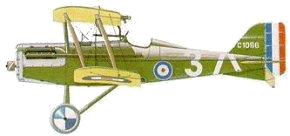|


Shortly after the development of the Scout Experimental 5, the improved
S.E.5a was introduced. When it entered the war in 1917, it was superior
to all its German opponents. Many pilots preferred it to the Sopwith
Camel. It was easier to fly, it performed better at high altitude and
its inline engine produced less noise. It was also faster than the
Camel, allowing a pilot to break off combat at will. Disdained by
Albert Ball, in the hands of airmen like William Bishop and Edward
Mannock, the S.E.5a developed a reputation as a formidable fighter.
With 54 victories, South African Anthony Beauchamp Proctor downed more
enemy aircraft with this plane than any other ace. 207 pilots died in
combat and 79 pilots died from non-combat related causes while flying
the S.E.5 and S.E.5a during World War I.
Country: Great Britain
Manufacturer: Royal Aircraft Factory
Type: Fighter
Entered Service: 7 April 1917 (S.E.5)
June 1917 (S.E.5a)
Number Built: 5,205 (S.E.5 and S.E.5a)
Engine(s): Hispano-Suiza, water cooled, 200 hp (manufacturing problems)
Wolseley W4a Viper, 200 hp
Wing Span: 26 ft 7 3/8 in [8.11 m]
Length: 20 ft 11 in [6.38 m]
Height: 9 ft 6 in
Empty Weight:
Gross Weight: 1988 lb [902 kg]
Max Speed: 120 mph [193 kmh] @ 15,000 ft [4572 m]
Ceiling: 19,500 ft [5944 m]
Endurance: 2.5 hours
Crew: 1
Armament: 1 Vickers .303 (port side of the fuselage)
1 Lewis .303 gun (mounted atop the upper wing) |
